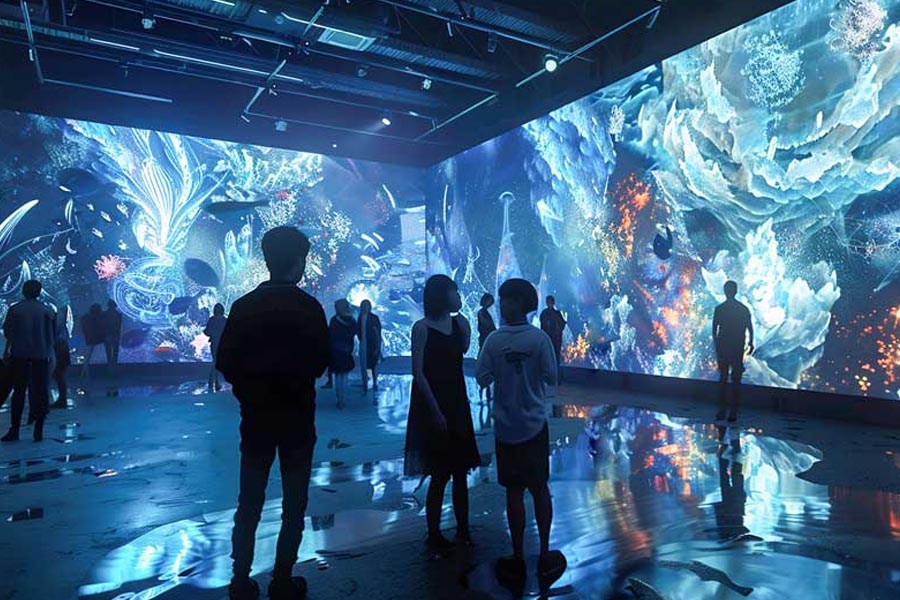Now Reading: The Era of Seamless Visual Experiences: How Tech Is Changing What We See
-
01
The Era of Seamless Visual Experiences: How Tech Is Changing What We See
The Era of Seamless Visual Experiences: How Tech Is Changing What We See

Why Seamless Visuals Have Become the Norm
Picture this: you’re sunk into your couch, lights dimmed, as a blockbuster unfolds on your massive home theater screen. No pixelated glitches, no awkward pauses—just pure, fluid magic pulling you into the story. That’s the world we’re living in now, where seamless visuals aren’t a luxury; they’re the baseline expectation. From binge-watching sessions to high-stakes boardroom presentations, we’ve all grown accustomed to screens that respond like they’re alive, syncing effortlessly with our every click or swipe.
But let’s rewind a bit. It wasn’t always this way. Remember the early days of digital displays, when a simple video switch could cause a flicker or a lag that yanked you right out of the moment? Those hiccups feel ancient now. Today, in our hyper-connected lives, visuals are the heartbeat of how we connect, learn, and entertain ourselves. Think about scrolling through social feeds on your phone, where videos autoplay without a stutter, or joining a virtual concert where the lights and beats pulse in perfect harmony. It’s all about immersion, that cinematic rush where the tech fades into the background, leaving you fully engaged.
What’s driving this shift? Our brains crave smoothness—studies show that even tiny delays can spike frustration levels, turning a thrilling game into a rage-quit fest. In professional realms, it’s even more critical: a split-second glitch in a security feed could mean missing a vital detail. So, industries have pivoted hard toward tech that delivers real-time perfection, blending high-res with lightning-fast processing. It’s like upgrading from a clunky old film reel to a sleek digital projector that never skips a frame.
A Growing Demand Across Multiple Sectors
Zoom out from your living room, and you’ll see this visual revolution spilling into every corner of life. Start with entertainment: massive LED walls at concerts where visuals dance in sync with the bass drops, creating those goosebump moments for thousands. Or high-end gaming rigs that render worlds so vividly, you forget you’re holding a controller. It’s not just fun—it’s transformative, turning passive viewers into active participants.
Now, flip to the corporate side. Imagine a bustling conference room where digital signage flips seamlessly between slides, or remote teams collaborating on shared screens without a hint of lag. These tools aren’t flashy add-ons; they’re the glue holding global operations together. In control centers—think air traffic or utility monitoring—operators lean on crystal-clear, synchronized displays to make split decisions that keep everything running smoothly. One wrong pixel, and chaos ensues.
Broadcast and event production? That’s where the real wizardry happens. Pros juggle live feeds, camera switches, and on-the-fly edits, all while ensuring the output is flawless for audiences worldwide. From sports arenas beaming instant replays to virtual events streaming in 4K, the demand is skyrocketing. And don’t overlook retail or education, where interactive displays pull you in, making shopping or learning feel like an adventure. Across the board, the common thread is this: seamless visuals build trust, boost engagement, and elevate experiences from mundane to memorable.
The Vital Role of the Video Processor
At the heart of this visual symphony sits the video processor, the unsung hero orchestrating the show. Think of it as the director behind the scenes, pulling strings so everything looks effortless. This powerhouse hardware takes in feeds from cameras, computers, media players—you name it—and weaves them into a cohesive tapestry.
What does it actually do? For starters, it switches inputs in real time, no black screens or awkward freezes. Picture merging live video with graphics overlays during a news broadcast, all without missing a beat. It scales content dynamically, adjusting resolutions to fit any screen size, from a tiny monitor to a sprawling video wall. And latency? Forget about it—these processors keep visuals locked in sync with audio, ensuring that lip-sync nightmare never haunts your setup.
But it gets deeper. Signal distribution across multiple displays happens without a drop in quality, like feeding a hungry crowd from one kitchen without skimping on portions. Synchronization is key too, making sure every screen tells the same story at the same moment. In essence, the video processor turns chaos into clarity, handling the heavy lifting so you can focus on the wow factor.
Technologies Enabling Seamless Visuals
Dive into the tech toolkit, and you’ll uncover innovations that make all this possible. Ultra-low latency processing is the star here, slashing delays to mere milliseconds for live gigs or interactive apps—imagine a surgeon relying on real-time visuals during a remote procedure. Support for sky-high resolutions like 4K and 8K pushes boundaries, especially on massive displays where every detail counts.
Connectivity is another game-changer, with compatibility across HDMI, SDI, DisplayPort, and more, letting you plug in without headaches. Intelligent switching adds flair, like buttery-smooth fades that transition scenes as if they’re part of a Hollywood edit. For high-stakes spots, built-in redundancy kicks in, providing backups so the show goes on even if something falters.
These aren’t just bells and whistles; they’re the foundation for environments where visuals must be rock-solid. From adaptive scaling that tweaks on the fly to multi-source blending that layers content like a pro editor, the tech stack is evolving to meet our insatiable appetite for perfection.
The Video Processor You Can Trust: DEXON’s Video Processors
When it comes to picking a champ in this arena, DEXON’s lineup steals the spotlight. These beasts are engineered for the toughest gigs—control rooms buzzing with data, corporate hubs pulsing with presentations, broadcast studios cranking out live content, or event stages alive with energy. What sets them apart? A knack for juggling multiple sources with ease, delivering ultra-low latency that feels instantaneous.
Seamless switching is their secret sauce, flipping between inputs like a DJ mixing tracks without dropping the beat. Tailor them to your needs: a solo LED wall for a boutique setup or a sprawling multi-screen monster for grand spectacles. Reliability is baked in, with features that handle the heat of mission-critical ops. It’s like having a trusty sidekick that anticipates your moves, ensuring visuals pop with precision and punch.
Smarter Visual Infrastructure, Better Experiences
As screens get smarter and setups more intricate, the backbone tech has to keep pace. A top-tier video processor bridges the gap, turning raw inputs into polished outputs that dazzle. In global meetings, it powers presentations that flow like well-rehearsed scripts, drawing in participants from afar.
For high-stakes events, it’s the linchpin, syncing lights, sounds, and sights into an unforgettable spectacle. Surveillance ops rely on it for unblinking accuracy, where every frame could be a clue. The beauty lies in the subtlety—tech that works so well, you forget it’s there, letting the visuals steal the scene.
In this fast-evolving landscape, infrastructure isn’t just support; it’s the spark that ignites better, bolder experiences. Whether crafting immersive worlds or driving data-driven decisions, the right tools elevate the ordinary to the extraordinary, frame by flawless frame.
FAQ
What exactly is a video processor?
A video processor is hardware that manages, switches, scales, and synchronizes visual content from various sources to ensure smooth display across screens. It handles everything from real-time input switching to low-latency output, making complex setups feel effortless.
Why are seamless visuals so important today?
Seamless visuals prevent disruptions like lags or glitches that can break immersion in entertainment or cause errors in professional settings. They enhance engagement and reliability, meeting modern expectations for fluid, high-quality experiences in daily interactions.
In which sectors are video processors most commonly used?
Video processors shine in entertainment for LED walls and projections, corporate spaces for signage and collaborations, control centers for monitoring, and broadcast for live production. They’re essential wherever multiple screens and real-time syncing are key to operations.
What makes DEXON’s video processors stand out?
DEXON processors excel with multi-source management, ultra-low latency, and seamless switching tailored for demanding environments like control rooms and events. Their reliability and customization options make them a go-to for professional-grade visual performance.
How do technologies like ultra-low latency improve visual experiences?
Ultra-low latency ensures immediate responses in interactive or live applications, keeping visuals in perfect sync with actions or audio. This tech supports high-res formats and redundancy, delivering precise, uninterrupted displays crucial for immersive and critical uses.





















